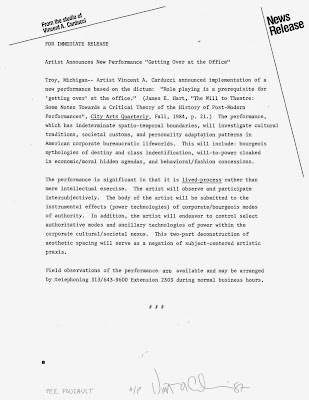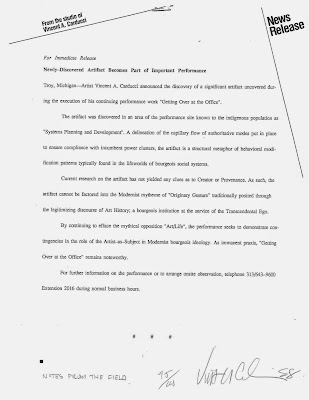 |
| Vince Carducci, Getting Over at the Office (1987-2000). Performance documentation, installation view. |
In May 2014, the online journal ∞ Mile published an essay about my performance piece Getting Over at the Office (1987-2000) under the title "How I Got Over." Documentation and artifacts from the performance are now on view at College for Creative Studies Center Galleries until December 13. I am giving a gallery talk on Tuesday, November 18, at 11:30 am. I want to thank CCS Center Galleries Director Michelle Perron for the opportunity to revisit this project. Also, thanks to Matthew Hanna for the installation and Crista Deneau and Charlie Grover of the CCS Audio Visual Center for A/V assistance. Thanks as well to Steve Stanchfield of the CCS Entertainment Arts Department for transferring "vintage" Betamax videos to digital format. Finally, thank you to Gary Kulak and Nora Dillon for lending items from their collections to the exhibition. Below is a slightly edited version of the ∞ Mile essay, which also features some additional content.
How I Got Over
By Vince CarducciLike most people in the arts, for many years I supported my artistic activities, along with the rest of my life, by holding down a day job. Corporate communications and advertising primarily in financial services were not such a bad gig, actually, and, in fact, were what I trained to do by having a dual major in graphic design and painting. For the last 13 years of that time, I also mounted a performance piece, Getting Over at the Office (1987-2000), whereby I recoded aspects of my daily work life as art through a series of artifacts and documents. Much of the documentation consists of news releases, sent out intermittently to a mailing list that grew with time. The performance was a gesture through which I sought to reclaim the time that had been appropriated from me by the capitalist system.
 |
| "Per Foucault" (1987). |
Whereas most performance art is virtual—that is to say play-acting within the privileged sphere of what philosopher and art critic Arthur C. Danto calls the artworld—my performance was for real. I set about slogging through the shit of the corporate bureaucracy and endeavored to come out on top. (In truth, this is what many of us must do in this wretched world. As the bumper sticker reads: “I owe. I owe. It’s off to work I go.”) I began the performance in the late 1980s when appropriation was all the rage in the artworld. Again, I believed that my performance had a level of reality most appropriation art did not because I actually stole from the company—the time I spent writing the news releases and duplicating them, the stationery, envelopes, and postage used in mailing them out, the copy machines and computer technology necessary for production, and other resources, such as paper clips, computer disks, and anything else lying around the office that I might need to do the work. Another aspect of the performance is the question of identity: “Who is the ‘real’ Vince Carducci? Subversive artist? Office drone?” As Lacan teaches with regard to the decentered self, most famously in the essay in Ecrits on the mirror stage where he notes that the ego’s reflection of itself is always already a misrecognition, it can go either way.
 |
| "From the Archive" (1987). |
Over the course of the performance, documentation was released to mark sundry, noteworthy events. Every time I received a title change, for example, a release would go out with my new business card attached and a detail of what the new status entailed—stock options, an assigned parking space, a bigger office, etc. Sometimes the news release provided a convenient cover for what sociologists call role strain, the stress experienced when behavior, expectations, or obligations associated with performing a social role conflict with one’s basic sense of self. An example of this is the release carrying the headline “‘Getting Over’ Goes Over the Edge” (1992) documenting my decision, years in the making as an aging hippie, to shave my beard in order to better fit into the expected look of a bank executive, again calling identity into question. Others documented some of the odd rituals of corporate life including, for example, the first time the CEO invited me to address him by his first name instead of “Mr. So-and-So Big Shot,” which became the subject of the release “‘Getting Over’ Artist Gets Inside” (1993).
 |
| "'Getting Over' Goes Over the Edge (1992). |
 |
| "'Getting Over' Goes Over the Edge," detail. |
 |
| "Notes From the Field" (1988) |
 |
| "Notes From the Field," detail. |
 |
| "A Piece of the Action (for Mary M. Denison)" (1992). |
By that time, I was high enough in the corporate chain of command that the article was viewed as positive PR for the bank and not some scandal, which it certainly would have had it come out a few years earlier. Our CEO, “Tom” as I called him, was a collector and trustee of the Detroit Symphony Orchestra, and he knew many of the people in the Detroit artworld who, although they were not all aware of my performance, certainly knew who I was as an exhibiting artist and, more importantly, a critic who published nationally. Many high-net-worth individuals are, of course, movers and shakers in the arts. In my case, the two worlds comfortably collided as I often gave tours of the bank’s contemporary art collection to current and potential private banking clients, including regaling them with art talk over an expense-account lunch in the executive dining room. At that point, among my duties was serving as Tom’s personal ghostwriter, and, therefore, repudiating me would have been a tremendous embarrassment for him. Instead, following Tom’s lead, people around the office congratulated me on being such a shining example of the bank’s diverse work force.
The performance gained a level of artworld legitimacy with its inclusion in the Franklin Furnace Archives, now part of the Museum of Modern Art in New York City. I also turned one of the video narratives (see below), detailing my experience upon entering the junior executive ranks of receiving tie-tying lessons in the men’s room by not one but two senior vice presidents, into a piece of creative nonfiction published by the webzine PopMatters under the title “Ties That Bind.” Ironically, as much as the performance was a doubled-edged deconstruction of the art and corporate worlds, it also became my plan for success. Whenever confronted with role strain, I could simply and literally call it part of the performance, sending out a news release as a form of confession and then do what I needed to do. I am thoroughly convinced that it had a material effect on my actually getting over at the office by becoming Senior Vice President-Director of Marketing and Corporate Communications, the top job in my area reporting to the CEO.
The final gesture was to conclude the performance when I decided to quit my job and return to grad school. The last piece, “‘Getting Over’ Over and Out” (2000), has three parts: my letter of resignation to my then boss the Chief Operating Officer, my memo ghostwritten for the COO announcing my resignation and the company’s plan of succession, and the final news release announcing the end of the performance. Again, the question of identity is at play in that each of these documents, written in a different voice for a different audience, are all composed by the same individual.
 |
| "'Getting Over' Over and Out," parts 1-3 (2000). |
Below top: "Getting Over at the Office [18 July: 11:02-11:29]" (1988).
Below lower: "Tales of Male Bonding" (1989).


Thanks, Obiwan. Saw the Infinte Mile. Hope you see me at your gallery talk.
ReplyDelete-- LtD
Hope you can make it. Should be fun.
DeleteVery well orchestrated presentation today. Thanks for the invite. Enjoyed your storytelling. Small space back there. -- LtD
ReplyDeletesidenote: the little girl monitoring the Center Gallery this a.m. had no idea who you are nor awareness of your presentation about to begin. She's a new transfer from WSU who "just wants to paint more." (to hell with a liberal arts education).
Thanks for coming. To follow up on your question, while I felt pretty OK about the gang at SFB, I can't say that I felt the same about the people who bought us out. While it took a couple of years to build the exit strategy, I figured out pretty quickly that I didn't want to hang around them any longer than I had to.
Deleteglad you were able to get out with your dollop of shareholder value.
ReplyDeleteMe too.
Delete